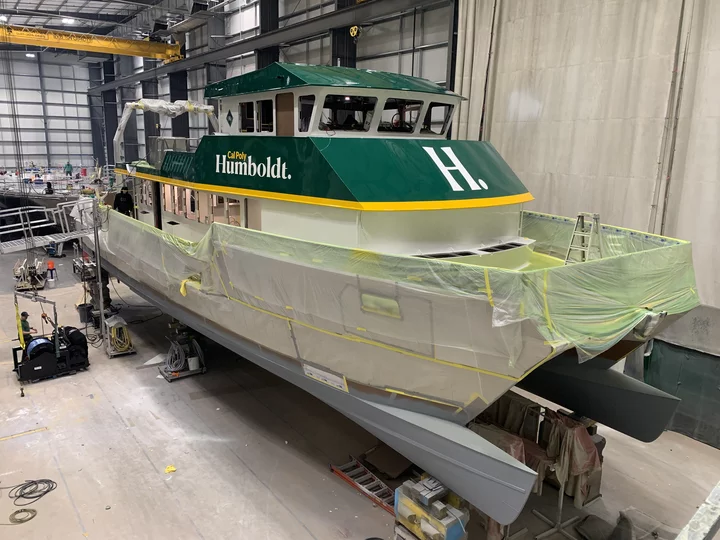The R/V North Wind will arrive in early 2025. Photo courtesy of All American Marine.
Press release from Cal Poly Humboldt:
The University’s new research vessel now has a name — the R/V North Wind.
The vessel’s name refers to the physical process that defines this region, driving the Pacific current, and contributing to ocean upwelling which provides the mild climate and rich fisheries along the North Coast. It drives the ocean swells that generate the rugged coastline and provides a steady stream of storms and moisture that leads to the temperate, wet climate that feeds the forests and grasslands.
The name was chosen as part of a collaborative process. In late October, the College of Natural Resources & Sciences launched a broad community survey with nine proposed names for the new research vessel. Nearly 2,000 students, staff, alumni, and community members responded to the survey, supplying 5,190 votes.
Thanks to this feedback, and in consultation with Tribal organizations, the R/V North Wind was chosen from the selection of name proposals. The name celebrates the region and speaks to the University’s strengths in the natural resources and sciences. It meets U.S. Coast Guard and general maritime industry standards and has been approved by the University Space & Facilities Advisory Committee in addition to the president.
The vessel will continue the University’s legacy of hands-on learning, supporting undergraduate and graduate marine research. It is set to arrive in February 2025.
“The R/V North Wind will expand our reach and capabilities in research and teaching throughout the North Coast,” Eric Riggs, Dean of the College of Natural Resources & Sciences said. “The new vessel adds capacity for addressing modern marine science, conservation, and economic issues that are directly relevant to communities and agencies in our region. It allows the University to be a full partner in the economic and scientific future of the offshore Blue Economy and allows our students to gain applicable skills and experiences in this growing area.”
The $8.5 million new research vessel is made possible by the state’s historic investment in Humboldt’s expansion as a polytechnic university.
The 78-foot-by-28-foot custom-built aluminum catamaran will travel at speeds up to 24 knots and can carry up to 40 students, faculty, and crew on research voyages. The vessel is equipped with a lab, a pilot house, diving platforms, and a variety of machinery for handling equipment and instrumentation. The lab and pilot house will carry state-of-the-art navigation and oceanographic electronics to measure the physical and biological features of the ocean floor and water column.
Research will continue aboard the University’s previous vessel, the R/V Coral Sea, until it is phased out for retirement from Cal Poly Humboldt by 2026 when the state’s new emissions standards take effect. The new emissions standards would require all of the vessel’s five engines to be replaced to operate in California. Though it has been well maintained, it is 50 years old and has far exceeded the average 30-year lifespan of a research vessel. For decades, the Coral Sea has supported undergraduate and graduate educational programs, allowing thousands of students to learn the basics of seamanship while also gathering and analyzing data on everything from fish to sediment.
Part lab, part floating classroom, the North Wind will advance the University’s ability to prepare students and train the next generation of marine scientists.

CLICK TO MANAGE